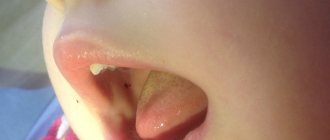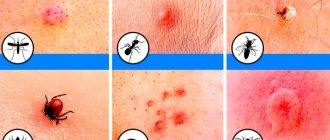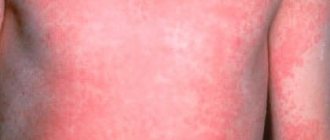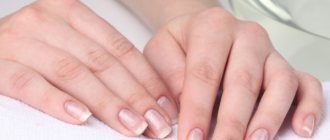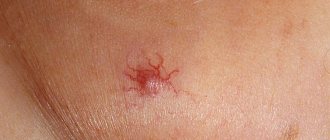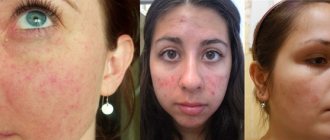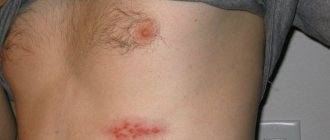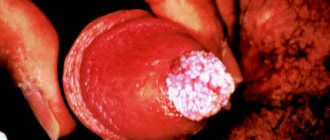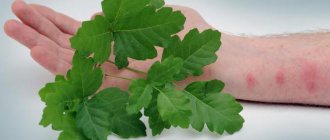The appearance of bruises and hematomas on the surface of the hands most often occurs due to injury to the skin. But when such symptoms appear for no apparent reason, you should be concerned. Since in most cases they indicate the development of serious pathological processes in the body. Now we’ll try to figure out why bruises appear on our arms.
Causes of bruises on the arms
If you have not received any injuries, bruises may appear for the following reasons:
- Hemorrhagic vasculitis. This disease is characterized by the development of an inflammatory process that affects small vessels located under the skin. Most often, the cause of its development is autoimmune mechanisms and various malfunctions in the body. When this pathology occurs, capillaries rupture, causing blood to penetrate into the subcutaneous tissue, which manifests itself in the form of bruises on the arms or other parts of the body.
- Vitamin C deficiency in the body. This vitamin takes part in many processes, including blood circulation. It is responsible for capillary permeability and normal blood clotting. When the body is deficient in this vitamin, bleeding often occurs inside it, which results in bruising. The first symptom of vitamin C deficiency is bleeding gums, followed by bruising on the body.
- Vitamin P deficiency. This vitamin helps strengthen the skin and the walls of blood vessels. That is why, with its deficiency, as in the case of a lack of vitamin C, unpleasant symptoms in the form of bruises may appear.
The solution to the last two reasons is very simple. You just need to include foods high in these vitamins in your diet. It is also advisable to regularly take vitamin complexes, which will constantly maintain optimal levels of vitamins and minerals in the body.
What pathologies can cause bruises on the arms?
A bruise on your arm cannot appear without a reason. If you have not received any injuries, then it is likely that the occurrence of this symptom is associated with the development of diseases. For example:
- blood clotting disorder (can be either hereditary or acquired);
- malignant blood diseases;
- cirrhosis of the liver;
- various kinds of infectious diseases;
- inflammatory processes in the body that have become chronic;
- taking various medications that affect blood circulation (this includes analgesics, antidepressants, anti-asthma drugs and many others).
Remember that the appearance of bruises on the body, in particular on the arms, can be caused by strength loads, taking certain medications, as well as hormonal imbalances. In addition, a bruise on the arm may appear after taking a routine blood test from a vein or finger.
Quite often, older people experience the appearance of bruises on the body. This happens due to age-related changes in the body, which lead to fragility and fragility of blood vessels.
How to deal with bruises on your arms at home?
If the appearance of bruises on your hands is caused by the development of any kind of disease, then you need to fight them with the help of special medications that will affect the cause of their appearance. At home, you can take various measures that will help eliminate these symptoms.
If we talk about traditional medicine, then there are many ways to get rid of hematomas and bruises. The most popular of them are:
- applying a cotton swab to the damaged area, which is pre-moistened in a strong infusion of chamomile;
- applying a cabbage leaf steamed in boiling water to the bruise (fix it with a bandage and walk with it for several hours);
- applying a compress of dried comfrey leaves to the damaged surface of the hand at night;
- treating the bruise with a mixture of vegetable oils;
- treating the damaged surface with an ointment containing calendula extract;
- applying a cut aloe leaf to the bruise.
If the appearance of bruises on your arms is associated with an injury, then you can use the following methods. The first step is to apply a cold compress to the damaged area. Do not hold it for more than 15 minutes, as this can lead to vascular damage and frostbite.
If the bruise does not go away within two days, you can begin treating it with warm compresses, which have a resolving effect, or resort to physical therapy. For this, various topical gels and ointments are used, which contain bodyaga and hirudin.
These components have a local absorbable and anti-inflammatory effect. They should be used several times a day (more detailed information about their use can be found in the instructions). In the fight against bruises, ointments such as Lyoton 1000 and heparin ointment have also proven themselves to be effective.
Remember that effective treatment of bruises on the arms can only be achieved through complex treatment of the affected area. If you were unable to independently identify the cause of this disease and eliminate it, then be sure to seek help from a specialist.
You may have serious illnesses that require complex and lengthy treatment. There is no point in postponing treatment until later, as bruises on your arms will appear more and more often, which will cause you a lot of discomfort in everyday life. Be attentive to your health!
How bruises appear
Small blood vessels surround our entire body, from our head to our toes. Due to an impact or fall, blood vessels burst, blood enters the subcutaneous tissues, externally this process is visible as the appearance of black, blue or purple spots. A bruise, as people say, or a hematoma in medicine.
Most blood ruptures do not pose any danger to the human body : after 3-9 days the blood resolves and no trace remains of the purple spots. However, there are also severe cases, for example, with a strong fall, swelling appears within an hour, the hematoma is visually much larger than ordinary bruises, and the bruised area aches and hurts. In this case, immediately consult a doctor to identify the cause: it could be a fracture, dislocation, or even rupture of ligaments and tendons.
If a person leads an active lifestyle, engages in extreme sports and does not like to sit still, ordinary bruises on the arm are his eternal companions. Jumped wrong, accidentally hit, tripped, fell—it’s impossible to list everything, so you don’t need to pay close attention to such hematomas, just learn to be more careful. However, if the bruise on the arm is painful or often appears in “quiet homebodies,” you should consult a doctor to find out the cause of the appearance.
A bruise on the arm can also occur after an IV. If the needle is inserted incorrectly, the saline solution begins to accumulate on the internal tissues rather than flow through the venous vessels. First, the site of incorrect injection begins to swell, and the very next day a noticeable bruise appears. This situation can happen due to the inexperience of medical personnel, as well as if the walls of the vessels are too weak or it is very difficult to find a vein. Such a hematoma is not inconvenient, but just a little painful at times.
A hematoma can also appear after surgery on the arm. For example, when suturing or other activities, hematomas may form. They dissolve gradually; you just need to lubricate the area with an anticoagulant, which prevents bruising.
On average, a person has more than 150 billion capillaries, but such a large number should not give reason to be wasteful about the health of your body. In addition, a bruise on your arm cannot give you beauty, but on the contrary, it will only ruin it.
Consequences and complications
If a hematoma appears frequently and for no reason, in this case only a specialist will help. Thanks to him, a diagnosis will be made in a timely manner and treatment of the underlying disease will be prescribed.
Mild forms of damage go away on their own. If the hematoma on the arm from the blow is complex and extensive, then complications may arise. If the bruise should have been opened, but this procedure was not performed, scar tissue may form or suppuration may appear. This leads to constrained hand movement and discomfort.
Partial resorption of the hematoma leads to purulent-inflammatory processes. If you continue to not consult a doctor, the situation will worsen and sepsis, necrotization, tissue rejection or blood poisoning may occur. Therefore, you should not joke with extensive hematomas.
Types of hematomas. General types.
There are such types of hematomas as:
• Bruising during pregnancy – retrochorial. Such a hematoma is very dangerous for both the fetus and the mother. Due to the rupture of the connection between the fertilized egg and the placenta, a hematoma occurs with a diameter exceeding 10-15 cm. During this process, the child’s nutrition stops, and if urgent measures are not taken, the fetus may die, and enormous damage to the mother’s health will be caused.
• A brain hematoma can manifest itself with terrible pain in the occipital or frontotemporal region. With a strong impact, not only external tissue can be damaged, but also internal organs. An examination such as an MRI will help identify pathology.
• Epidural hematoma forms under the cranial surface. It brings a lot of troubles: headaches, increased eye pressure, general weakness of the body.
• Subdural – the most dangerous for human life. Located between the hard and archanoid surfaces of the head, the hematoma has a strong effect on the functioning of the brain, which can even cause a person to die.
You need to know the varieties listed above in order to prevent yourself from dire consequences in time. Even if you are interested in a bruise on your arm, information on the types of hematomas available will always be necessary and relevant.
Vascular spots
Such spots are red in color and have a mostly smooth surface, but sometimes they may have a slightly rough surface. Usually they are located flush with the skin, but sometimes they can still protrude somewhat above its surface.
Burgundy spots on the skin are divided into:
- Hyperemic (i.e. overflowing with blood), having inflammatory and non-inflammatory origin. In the first case, the spots are formed as a result of the expansion of blood capillaries due to the inflammatory process and can be of various sizes - less than 2 cm in diameter (roseola). In the second case, the spots are larger than 3 cm (erythema). The formation of such defects on the skin is also caused by the dilation of blood vessels, but it occurs due to various strong emotions (feelings of shame, rage, anger or anger). They are most often found on the face, chest and neck.
- Hemorrhagic. They are formed due to hemorrhages in the skin due to external strong mechanical action or as a sign of certain diseases affecting blood vessels. These may be ordinary bruises, then they disappear on their own after 1 or 2 weeks, but in other cases more serious therapy will be needed.
Vascular spots come in various shapes and are most often small in size, which often merge together into one large red formation.
Bruise on the arm. How to understand that a hematoma is dangerous?
Even if two people suffer the same degree of bruise, each hematoma will be unique. It depends on age, general health, and the presence of vitamins in the body. A normal bruise on the arm goes away in about 4-5 days. During this time, the blood gradually resolves and the bluish tint from the skin slowly disappears. The bruised area does not hurt, does not restrict movement and allows you to do your previous work.
However, a bruise is not always accompanied by such mild symptoms. A hematoma, which can cause significant damage to the body, is accompanied by the following symptoms:
• Severe aching pain
• Increase in size of the bruise
All of them fit the type of internal hematoma, that is, internal organs are damaged, not external tissues. Of course, they are not present on the hand, but complications such as ligament rupture, joint dislocation, sprain, open fracture are possible, in which bruising is also observed. Very often, people with impaired blood clotting suffer from the formation of blood clots. In appearance, it is very similar to a bruise, but their etiology is completely different. If you are concerned about a thickened area on your arm, you should contact a phlebologist.
If you are feeling unwell or in severe pain, you should urgently call an ambulance. In case of the listed misfortunes, qualified assistance can only be provided in a hospital under the constant supervision of a doctor.
Lichen spots
Ringworm is one of the most common skin diseases that are of viral or bacterial origin. Its appearance is manifested by specific changes in the skin, and in some cases also by incessant itching and pain. Usually, the start of lichen is a general drop in the level of immunity against the background of previous infections or chronic physical or mental fatigue.
Bruises on the arms for no reason. What to do?
Bruises on the arms for no reason, that is, without visible mechanical damage, are grounds to take the condition of your body more seriously. Bruises appear due to the rupture of small capillaries, their fragility and instability, only in the absence of external influence on the skin. You need to know several unexpected reasons why hematomas develop:
• HIV infection. Representing a painful condition for the entire body, small vessels are not left out. Bruises with this disease occur permanently, appear unexpectedly, and also disappear unexpectedly.
• Oncological diseases.
• Lack of vitamins , especially vitamin C. This common one is involved in the formation of all types of tissue, including capillary tissue.
• Hemorrhagic vasculitis . During such an illness, the immune system begins to produce antibodies against the vascular system, causing hematomas to appear not only on the hands, but throughout the body.
• Hormonal imbalances, for example, during menopause in women, can cause bruises on the arms.
• Elderly age. The capillaries become thinner, and the possibility of bruising increases several times.
• Diseases associated with blood clotting disorders.
If you are tormented by bruises appearing on your arms out of nowhere, you need to urgently consult a phlebologist, a doctor who specializes in blood vessels. After carrying out the necessary tests, which necessarily include a coagulability test, an ultrasound examination of the blood vessels. After the results are obtained, the doctor will prescribe appropriate medications or vitamins, but if necessary, refer you to another highly specialized doctor.
When should you be wary?
The red dots (angiomas) themselves are not dangerous. It is quite possible to live with small formations that are not injured or irritated by anything.
It is worth visiting a doctor if the following changes occur on your body:
- The formation began to grow or changed color - for example, it turned black.
- The outlines changed - the edges began to loosen, the “mole” acquired an irregular shape.
- The area around the angioma is inflamed .
- Bloody discharge appears from the formation.
- The “mole” began to disintegrate and festered .
- Unpleasant sensations appeared - itching, soreness.
How to get rid of bruises on your arms. Home methods.
A bruise can greatly ruin your appearance. How to get rid of bruises on your arms? After all, no gold or diamond jewelry, expensive dresses or suits can hide the hematoma that “shines” on the arm. The best and most effective method is to immediately apply a cold object (for example, ice) to the site of the bruise after it appears. The blood will resolve faster only if these actions are performed immediately after the injury. Cold provokes a constriction of blood vessels, so the damage that has just occurred can either decrease or disappear altogether. However, it is worth knowing that the more time passes, the worse the result will be.
This method of dealing with bruises on the arm is not the only one. There are several other effective ways:
• Iodine network. An oldie but a goodie. Absorbed into the skin, iodine improves blood circulation and quickly removes unnecessary waste products.
• Warm compresses. They can be used only 2-3 days after the bruise appears. Warming up promotes tissue regeneration and helps get rid of the “trouble” as quickly as possible.
• Apple vinegar. Vinegar lotions should be applied 4-5 times a day - it improves tissue regeneration.
• Potato starch also helps in getting rid of bruises quickly. It is necessary to mix water with starch and apply this mixture to the bruise. The result will be noticeable after just a few procedures.
• Tincture of vodka and parsley. A folk method, known from grandmothers, and very effective. 50 grams of parsley should be mixed with 250 grams of vodka. Moisten the bandage and bandage the bruised area.
• Cabbage and plantain have a magical property: they “pull out” swelling and help get rid of the hematoma as quickly as possible.
• Fresh wormwood juice. Crush the grass and apply the resulting juice to the bruise on your arm. And due to the special substances contained in wormwood, the bruise decreases right before your eyes.
• Pharmacy inexpensive ointments. The most popular of these is heparin, a local anticoagulant. After rubbing just a few drops of the drug, you will notice that the bruise begins to resolve, as the active ingredient heparin increases blood circulation and destroys the accumulation of burst blood capillaries.
Prevention of bruises on the arms
The main cause of bruising is capillary fragility. In order to prevent the occurrence of hematomas, it is necessary not only to reduce the likelihood of receiving various types of injuries, but also to take vitamins that help restore the walls of the capillaries.
Prevention of bruises on the hands comes down to the following types of measures:
• Regularly take vitamins B, C and K or include in your diet foods high in them: peppers, beans, peas, cheese, eggplant, raisins, pumpkin, cabbage, sea buckthorn, black currants.
• Reduce the use of aspirin and its derivatives. Due to the fact that acetylsalicylic acid thins the blood, bruising is a very common occurrence with regular use of this drug. Take aspirin only as prescribed by your doctor.
• Take folic acid, which is involved in the formation of tissue cells and support of the whole body (most effective in combination with B vitamins)
• Be more careful at home, on vacation and at work.
To determine why bruises appear on your arms for no reason, you need to undergo an examination at a medical facility. Many people have had a situation where they discovered a small hematoma on their body, although they did not receive any injuries.
Causes
Bruises and hematomas appear on human skin most often due to external mechanical damage (impact). Doctors say that more than 80% of bruises on our skin are traumatic. It often happens that a person does not even remember the injury received and thinks that the bruise occurred by itself. If a bruise appears on your arm, then this is normal, this happens to everyone. You should start to worry when such damage occurs frequently or for no apparent reason. Such symptoms are a sign of significant disturbances in the functioning of the body.
If a person did not receive any injuries, then bruises could occur for a number of reasons:
- Hemorrhagic vasculitis is a disease that causes inflammation in the blood vessels under the skin. The cause of this disease may be improper functioning of the immune system. As a result of the development of this disease, a person’s subcutaneous capillaries begin to burst. Blood from the vessels enters the subcutaneous tissue, which causes bruises on the arms and legs.
- Lack of vitamin C. This vitamin is necessary for the normal functioning of many processes in the body, including blood circulation. It is responsible for vascular permeability and blood clotting. A low concentration of vitamin C in the blood leads to frequent capillary hemorrhages and bruising. The first sign of acute lack of ascorbic acid is bleeding gums.
- Vitamin P deficiency. With its deficiency, the skin loses its strength, the walls of blood vessels become more fragile. This combination of pathologies also entails manifestations in the form of hematomas and bruises.
- Lack of estrogen. Sometimes sudden bruises in women can be caused by hormonal imbalance. A deficiency of this hormone makes blood vessels fragile and brittle. Therefore, bruises can appear even with minor external influence. With a hormonal imbalance, a bruise can occur even with a simple finger press on the skin.
- Phlebeurysm. It is typical for older people, as well as for pregnant women. The veins begin to be clearly visible under the skin, the vessels lose their elasticity. Bruises occur quite often and do not disappear for a long time.
Infectious diseases
Skin spots can be one of the typical symptoms of viral infectious diseases, such as rubella, measles or chickenpox. It must be remembered that people who become ill with these diseases require mandatory treatment in the infectious diseases department of the hospital in order to prevent the further spread of each disease.
Each of these diseases has its own speed and direction of increase in red spots spreading over the surface of the body:
- with measles, they form first on the face and slowly move down the body;
- with rubella, the spots are predominantly located throughout the torso and extensor areas of the limbs and can temporarily disappear if pressure is applied to them;
- with chicken pox, red spots are evenly scattered throughout the body and covered with pustules.
Such eloquent symptoms cannot be ignored, so as not to trigger the disease that has begun to develop and to prevent it from causing further harm to the body.
Treatment options
Only doctors can say exactly why various bruises appear on the hands after conducting a series of special tests. At home, you can only help eliminate symptoms.
If there are failures in the production of estrogen, an endocrinologist or gynecologist may prescribe a complex of hormonal medications. If the cause of hematomas is varicose veins, then treatment will not be possible without consulting a phlebologist. He will determine an accurate diagnosis and prescribe a course of therapy. In most cases, the course of treatment will include taking venotonic drugs, as well as doing therapeutic exercises.
If there is a lack of vitamins in the body, you should change your diet.
You need to include foods rich in vitamins C and P in your diet. Regular intake of vitamin complexes can also improve skin health.
In the case where hepatitis is to blame for the appearance of bruises, it is necessary to treat this disease as quickly as possible, since bruises are far from the worst of the symptoms of this disease. If you delay treatment, hepatitis can become chronic.
